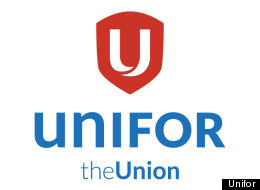Unifor, the new name for the super-union created by the merger of two of Canada’s largest unions, will help stem the decline in union membership and solidify the relevance of unions in an increasingly hostile labour environment, the head of the Canadian Auto Workers said Thursday.
The Canadian Auto Workers and the Communications, Energy and Paperworkers unveiled the name and logo for the union created by their merger, which will be made official on Labour Day weekend. It will be the country's largest private-sector union.
“The reality is that private sector unions have significantly shrunk over the last decade and the public sector is under significant attack,” said CAW president Ken Lewenza.
“There’s been a period of decline and, quite frankly, when there’s decline in the labour movement, there’s a decline in people’s living standards and we want to reverse that decline.”
The super-union is a response to what Lewenza describes as an increasingly hostile operating environment for labour organizations.
He cited the federal government’s growing propensity to intervene in labour disputes and implement back-to-work legislation, as well as the controversial Bill C-377, which would force unions to reveal where their union dues are used and signals that politicians across the country may be examining the potential for U.S.-style right to work legislation.
Unifor, whose logo is a red shield with a white “U,” will have more than 300,000 members at its outset. It will give the two unions a uniform presence across 20 different sectors, a development that Lewenza believes will give workers more leverage at the bargaining table.
There is strength in numbers and the new unified force will have the heft to stand up to employers looking to chip away at collective bargaining contracts, Lewenza said.
With part-time and contract work on the rise, the new union also plans to represent an increasing number of workers in “precarious working conditions,” he said.
The CAW had seen its influence and membership diminished by pressures on Canada’s manufacturing sector, particularly in the auto industry where it represents employees at General Motors, Chrysler and Ford, among others.
The CEP is also active in numerous industries that are under economic pressure, including forestry and media.
Original Article
Source: huffingtonpost.ca
Author: Sunny Freeman
The Canadian Auto Workers and the Communications, Energy and Paperworkers unveiled the name and logo for the union created by their merger, which will be made official on Labour Day weekend. It will be the country's largest private-sector union.
“The reality is that private sector unions have significantly shrunk over the last decade and the public sector is under significant attack,” said CAW president Ken Lewenza.
“There’s been a period of decline and, quite frankly, when there’s decline in the labour movement, there’s a decline in people’s living standards and we want to reverse that decline.”
The super-union is a response to what Lewenza describes as an increasingly hostile operating environment for labour organizations.
He cited the federal government’s growing propensity to intervene in labour disputes and implement back-to-work legislation, as well as the controversial Bill C-377, which would force unions to reveal where their union dues are used and signals that politicians across the country may be examining the potential for U.S.-style right to work legislation.
Unifor, whose logo is a red shield with a white “U,” will have more than 300,000 members at its outset. It will give the two unions a uniform presence across 20 different sectors, a development that Lewenza believes will give workers more leverage at the bargaining table.
There is strength in numbers and the new unified force will have the heft to stand up to employers looking to chip away at collective bargaining contracts, Lewenza said.
With part-time and contract work on the rise, the new union also plans to represent an increasing number of workers in “precarious working conditions,” he said.
The CAW had seen its influence and membership diminished by pressures on Canada’s manufacturing sector, particularly in the auto industry where it represents employees at General Motors, Chrysler and Ford, among others.
The CEP is also active in numerous industries that are under economic pressure, including forestry and media.
Original Article
Source: huffingtonpost.ca
Author: Sunny Freeman

No comments:
Post a Comment